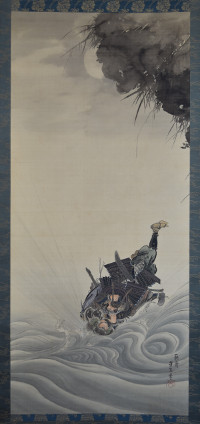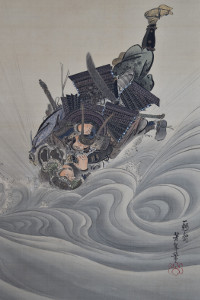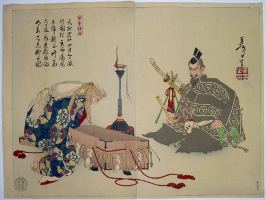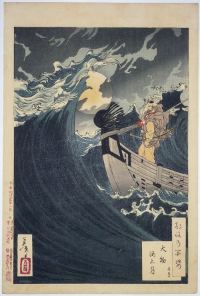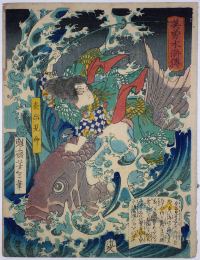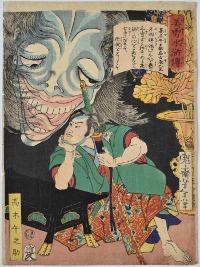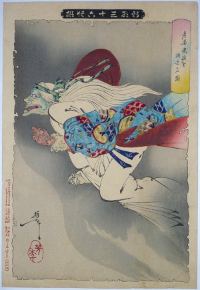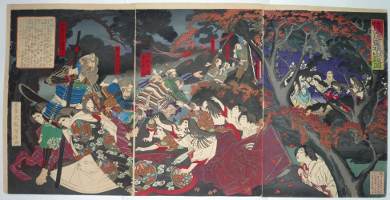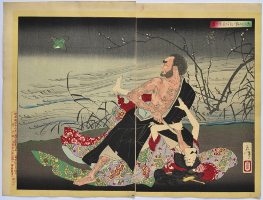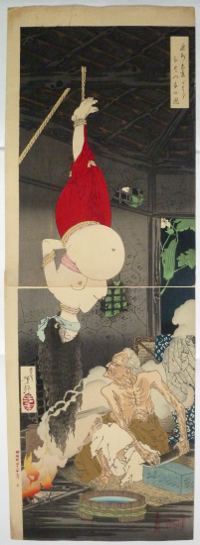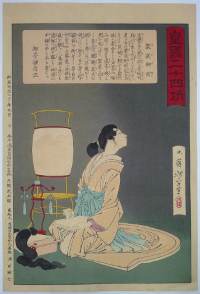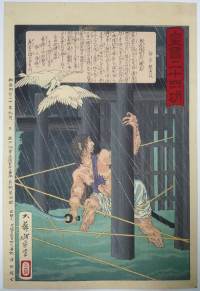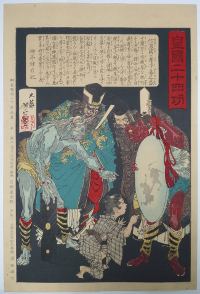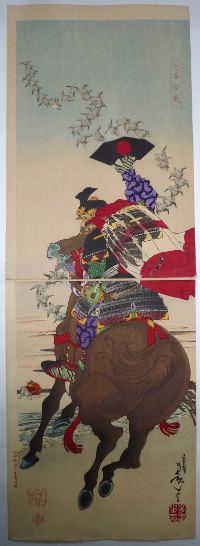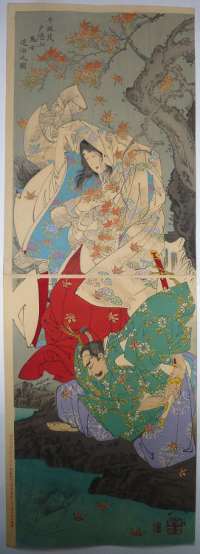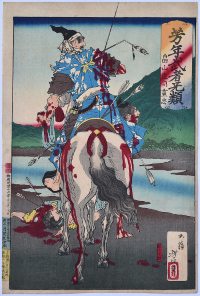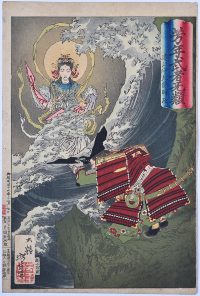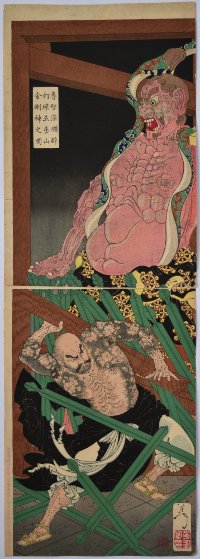Tsukioka YOSHITOSHI (1839-1892)
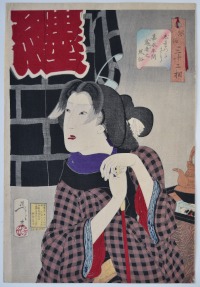
Click here to view image full size.
Jiki-tsuki-so: Kaei nenkan anego no fuzoku, “Looking as if Somebody is About to Arrive: The Appearance of a Fireman’s Wife in the Kaei Era [1848-1854].” A fireman’s wife waits for the return of the head of the household. From a set Thirty-two Aspects of Women published by Tsunashima Kamekichi, 1888. The set depicts women of different backgrounds and occupations from the Kansei era through to the Meiji era with punning allusions to their situation or mood.
Very fine impression of the true first edition. Fine colour and condition. Signed Yoshitoshi ga.
Status: Available
Tsukioka YOSHITOSHI (1839-1892)
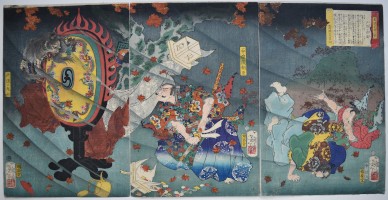
Click here to view image full size.
A triptych from a set Bidan musha hakkei, “Eight Views of Warriors’ Fine Tales.” This design Togakushi no seiran, “Clearing Weather of the Togakushi Mountains.” Princess Sarashina, who is actually a female oni called Momji, “Maple Leaves,” having transformed herself, is seen screaming from behind a giant drum and raising a high wind scattering maple leaves against Taira no Koremori Ason who draws his sword to kill her. Published by Sanoya Tomigoro, 1868.
Extremely fine impression of the earliest state. Fine colour. Slight marks on first sheet, otherwise very good condition. Signed Gekko Yoshitoshi hitsu.
Status: Available
Tsukioka YOSHITOSHI (1839-1892)
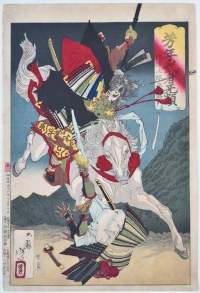
Click here to view image full size.
Shows Sagami Jiro Taira no Masakado on horseback attacking an opponent and having cut his sword in two. From a set Yoshitoshi musha burui, “Yoshitoshi’s Courageous Warriors.” Published by Kobayashi Tetsujiro, 1883.
Very fine impression: This is the first edition with three-colour cartouche and small red seals in left margin. There are late editions of this set. It was republished by Tsunajima Kamekichi in 1886. Fine colour. Slight soil bottom edge, otherwise very good condition. Signed Taiso Yoshitoshi ga.
Status: Available
Tsukioka YOSHITOSHI (1839-1892)
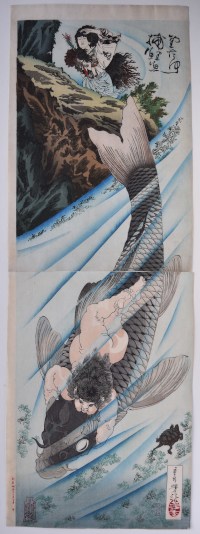
Click here to view image full size.
Kintaro rigyo o toru, “Kintaro Captures the Carp.” The “golden boy” of superhuman strength, a.k.a. Sakata no Kintoki and Kaidomaru, grapples with a giant carp which had been terrorizing the neighbourhood. There are conflicting stories about Kintaro’s origins but he is normally shown with his mother, Yama-uba, on Mount Ashigara where he developed a friendship with the mountain animals. The carp is associated with enormous strength and consequently needed great power to overcome it. From a set of fine vertical diptychs published by Matsui Eikichi, this design in 1885. It was republished by Hasegawa Tsunejiro in 1897. Arguably the best print from the set and one of Yoshitoshi’s finest designs.
Fine impression. Very good colour and condition. With full margins: This set often comes with the left margin, with the publication date, trimmed off. Signed Oju Yoshitoshi ga..
Status: Available
Tsukioka YOSHITOSHI (1839-1892)
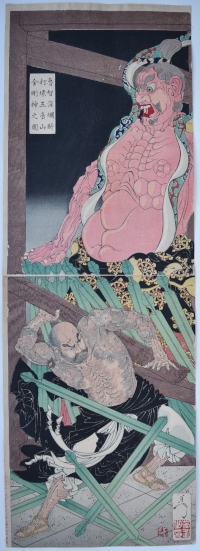
Click here to view image full size.
A vertical diptych showing Rochishin demolishing the temple gate on Mount Godai. There are conflicting versions of this event: Some suggest he gained entry to kill a gang of thieves. However, it seems that he was drunkenly staggering back to the temple after consuming a large quantity of wine and is barred entry by the monks. In a temper he demolishes the entrance and the large Buddhist guardian figure (Kongojin). The abbot dismisses him and sends him to a lesser temple. Rochishin ransui Godaisan Kongojin o uchikowasu no zu, “Picture of Rochishin in a Drunken Rage Demolishing a Guardian Statue (Kongojin) on Mount Godai.” Published by Matsui Eikichi, 1887. He figures in the Chinese classic Tales of the Water Margin, the Suikoden (jp. Suikoden) and is often referred to as the “Flower priest” because of his floral tattoos.
Very fine impression: This is the earliest state with a pigment used on the guardian’s torso that does not oxidise. (Exactly the same can be seen on the first editions of the Kinryusan Temple at Asakusa from Hiroshige’s 100 Views of Edo. Later printings use a different pigment on the huge lantern that oxidises badly.) It was also republished by Shimizuya Tsunejiro. Extensive burnishing. Fine colour. Very good condition. Signed Yoshitoshi.
Status: Available
Tsukioka YOSHITOSHI (1839-1892)
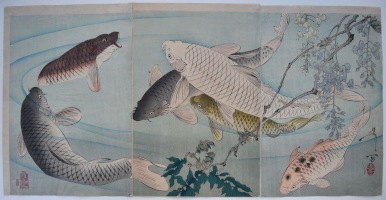
Click here to view image full size.
A triptych showing carp swimming beneath wisteria. A rare and extremely unusual subject in Yoshitoshi’s canon of work. Koi are symbols of love and friendship in Japan. The breeding of ornamental carp began in the 1820s. The outside world was unaware of the advances in breeding colour variations until an annual exposition in Tokyo in 1914. Published by Akiyama Buemon, 1889. There is an original drawing, most likely for this triptych, elsewhere on this site. A much sought after design.
Very fine impression. Fine colour. Completely untrimmed with the extra margins around. Fine condition. Signed Yoshitoshi ga.
Status: Available
Tsukioka YOSHITOSHI (1839-1892)
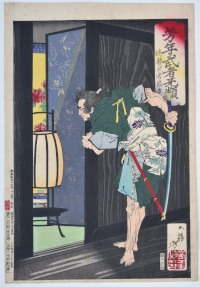
Click here to view image full size.
Shows Endo Morito about to murder Kesa Gozen’s husband in his bedroom. Morito became enamoured of Kesa Gozen although she was married to a palace guard. She eventually succumbs to his advances on the condition that he kills her husband. However, she takes the place of her husband in bed and is subsequently killed by him. Full of remorse Morito changes his name to Mongaku and does penance under the Nachi Falls. A famous scene much depicted in Japanese art. From a set Yoshitoshi musha burui, “Yoshitoshi’s Courageous Warriors.” Published by Kobayashi Tetsujiro, 1883.
Fine impression: This is the first edition with three-colour cartouche and small red seals in left margin. There are late editions of this set. It was republished by Tsunajima Kamekichi in 1886. Fine colour and condition. Signed Taiso Yoshitoshi ga.
Status: Available
Tsukioka YOSHITOSHI (1839-1892)
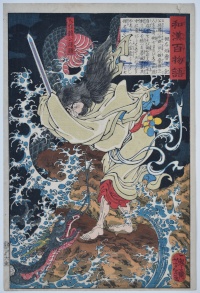
Click here to view image full size.
Shows Kon Sosho (Chin. Gongsun Sheng), a famous character from the Chinese popular novel Tales of the Water Margin (Jap. Suikoden). A Taoist sorcerer known as “Dragon in the Clouds” he was able to conjure up wind and rain, as here, where he is seen standing on a rocky promontory summoning up the Storm Dragon from the sea. From the set Wakan hyaku monogatari, “One Hundred Ghost Stories of China and Japan,” published by Daikin, 1865.
Fine impression and colour. Small backed wormhole in top right corner and has original album backing, otherwise very good condition. Signed Ikkaisai Yoshitoshi ga.
Status: Available
Tsukioka YOSHITOSHI (1839-1892)
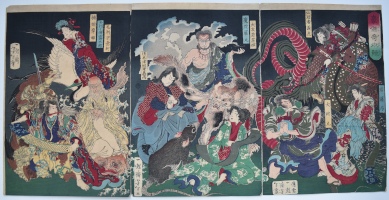
Click here to view image full size.
A triptych Goketsu kijutsu kurabe, “A competition Among Powerful Magicians.” Published by Masadaya, 1869. A compilation of well known sorcerers, wizards and magicians. From right to left: Iwafuji Tsubone, Senkanja Yoshitora, Orochimaru, Otomo Wakanahime, Madamaru, Sumizu Kanja Yoshitaka, Mori Soiken, Kusunoki Goma-hime.
Good impression, colour. Slight toning, otherwise good condition. Signed Ikkaisai Yoshitoshi hitsu, Ikkaisai Yoshitoshi ga, Oju Ikkaisai Yoshitoshi ga.
Status: Available
Tsukioka YOSHITOSHI (1839-1892)
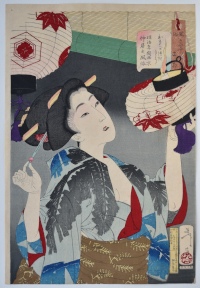
Click here to view image full size.
Okigatsuki-so: Meiji nenken saikyo nakai no fuzoku, “Looking Capable: The Appearance of a Kyoto Waitress in the Meiji Era [1867-1912].” Shows the waitress of a Kyoto geisha house whose job was to act as a go-between for customer and geisha. From a set Thirty-two Aspects of Women published by Tsunashima Kamekichi, 1888. The set depicts women of different backgrounds and occupations from the Kansei era through to the Meiji era with punning allusions to their situation or mood.
Very fine impression of the true first edition. Fine colour and condition. Signed Yoshitoshi ga.
Status: Available
Tsukioka YOSHITOSHI (1839-1892)
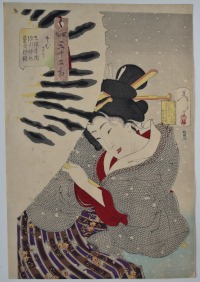
Click here to view image full size.
Samu-so: Tempo nenkan Fukagawa Nakamachi geisha fuzoku, “Looking Frozen: The Appearance of a Fukagawa Nakamachi Geisha in the Tempo Era [1830-1844].” Shows a beauty caught in a snowstorm, her umbrella laden with snow from a set Thirty-two Aspects of Women published by Tsunashima Kamekichi, 1888. The set depicts women of different backgrounds and occupations from the Kansei era through to the Meiji era with punning allusions to their situation or mood.
Very fine impression of the true first edition. Fine colour and condition. Signed Yoshitoshi ga.
Status: Available
Tsukioka YOSHITOSHI (1839-1892)
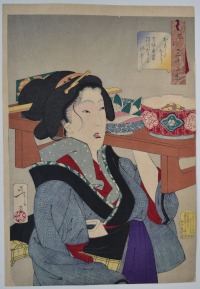
Click here to view image full size.
Omota-so: Tempo nenkan Fukagawa karuko no fuzoku, “Looking Weighed-Down: The Appearance of a Waitress at Fukagawa in the Tempo Era [1830-1844].” Shows the waitress carrying a portable wooden table with food to a geisha party from a set Thirty-two Aspects of Women published by Tsunashima Kamekichi, 1888. The set depicts women of different backgrounds and occupations from the Kansei era through to the Meiji era with punning allusions to their situation or mood.
Very fine impression of the true first edition. Fine colour and condition. Signed Yoshitoshi ga.
Status: Available
Tsukioka YOSHITOSHI (1839-1892)
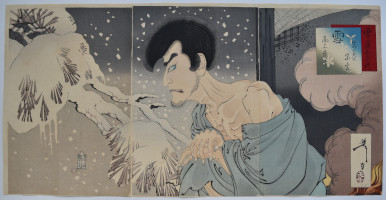
Click here to view image full size.
A triptych showing the priest Iwakura Sogen in a snowy garden. “Snow” from a set of three half-length portraits of actors with title: Setsugekka no uchi, “Snow, Moon, and Flowers.” Sogen was infatuated with the beautiful courtesan Irokotohime. He broke his vow of chastity and was expelled from his temple. Unfortunately, Irokotohime dies and Sogen is left with just his memories. There are other versions of this story and a play with the actor Onoe Baiko V. Published by Akiyama Buemon, 1890.
Fine impression of the first edition with variegated and unaltered sub-cartouche. Fine colour and condition. Signed Yoshitoshi ga.
Status: Available
Tsukioka YOSHITOSHI (1839-1892)
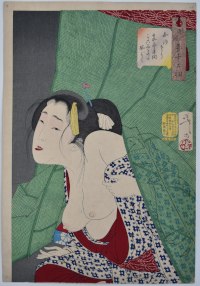
Click here to view image full size.
Looking Itchy: the appearance of a kept woman of the Kaei era [1848-1854]. Shows a beauty emerging from a mosquito net that has apparently not been entirely successful. From a set Thirty-two Aspects of Women published by Tsunashima Kamekichi, 1888. The set depicts women of different backgrounds and occupations from the Kansei era through to the Meiji era with punning allusions to their situation or mood.
Very fine impression with strong blind-printing on the fall. Fine colour and condition. Full size. Signed Hiroshige ga.
Status: Available
Tsukioka YOSHITOSHI (1839-1892)
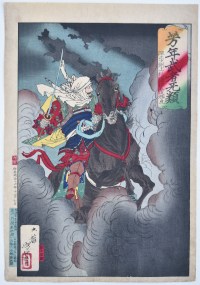
Click here to view image full size.
Uesugi Kenshin Nyudo Terutora. Shows Uesugi no Terutora (aka Kenshin) riding into battle through clouds of smoke against his long-standing adversary Takeda Shingen. From a set of 33 prints Yoshitoshi musha burui, “Yoshitoshi’s Courageous Warriors.” Published by Kobayashi Tetsujiro between 1883 and 1886, this being 1883. A fine design.
Very fine impression of the first edition. (Which should have a three-colour cartouche; two red seals and the publisher’s address in blue in the left margin.) It was reprinted by Tsunajima Kamekichi in 1886 and there are many late printings of the set. Fine colour and condition. Full size with extra paper at left. Signed Taiso Yoshitoshi ga.
Status: Available
Tsukioka YOSHITOSHI (1839-1892)
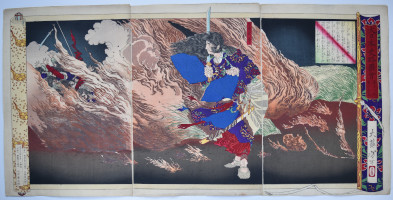
Click here to view image full size.
A triptych from a set of ten: Dai Nippon shiryaku zue, “Short Illustrated History of Great Japan.” Each print is in the form of an unrolled makimono. This design shows the third son of the twelfth century Emperor Keiko, Yamato Takeru no mikoto (Wo-usu). His father was constantly sending him on dangerous missions making him suspect that he wished his death. One such journey was to the Emishi in northeast Japan. On complaining about this to his high-priestess aunt, Yamatohime, she gave him the famous sword Ame no murakumo no hoken to aid him. On his arrival, the ruler of the Emishi lured him onto open grassland which he set on fire. Wo-usu used his sword to cut the grass, evade death, and start new fires to kill his enemy. Published by Kobayashi, 1880. A fine design.
Fine impression of first edition. Fine colour. Very slight crease bottom margin of centre sheet, otherwise fine condition. Signed Taiso Yoshitoshi.
Status: Available
Taiso YOSHITOSHI (1839-1892)
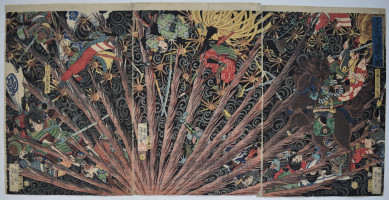
Click here to view image full size.
A triptych showing an exploding land-mine throwing bodies and horses into the ether. Taiheiki Masakiyo nansen no zu, “Masakiyo’s Difficult Battle from the Taiheiki.” Figures identified in the print are the 14th century warriors Sato Shukei no Kami Masakiyo and Shimura Masazo Katsutoyo, but by way of avoiding censorship, it is actually showing Kato Kiyomasa (1562-1611) and Kimura Matazo Shigekatsu. It may also be that the design alludes to the rogue samurai in Choshu Province during the summer of 1866. Published by Yamashiroya Jinbei, 1866. One of Yoshitoshi’s great designs. In fact, this is a reworking of a similar composition in a book early in his career, Ehon jitsugokyo dojikyo yoshu of 1853.
Fine impression and colour. Lovely oxidation of the orange pigment. Fine condition. Signed Ikkaisai Yoshitoshi hitsu.
Status: Available
Tsukioka YOSHITOSHI (1839-1892)
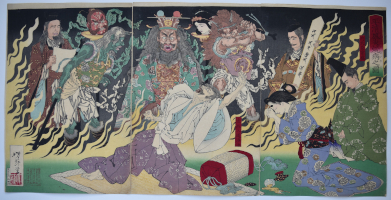
Click here to view image full size.
A triptych Taira Kiyomori hi no yamai no zu, “The Fever of Taira no Kiyomori.” Kiyomori’s wife, Niidono, dreams that the King of Hell, Ema, is coming for Kiyomori for his crime of burning the Rushana Buddha. His family gather around him and pray but to no avail. He dies on the 4/2/1181. Shows Niidono and her son beside a convulsed Kiyomori. Behind are visions of hell with Ema and figures who may have been Kiyomori’s victims. Published by Akiyama Buemon, 1883.
Fine impression, colour and condition. A lovely copy of this triptych. Signed Yoshitoshi ga.
Status: Available
Taiso YOSHITOSHI (1839 – 1892)
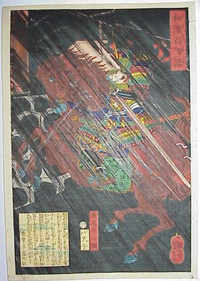
Click here to view image full size.
Watanabe no Tsuna on horseback in the rain. One of the finest designs from Wakan hyaku monogatari. Published by Daikin, 1865/2.
Fine impression and colour. Minor wormage otherwise very good condition. Signed Ikkaisai Yoshitoshi ga.
Status: Available
Taiso YOSHITOSHI (1839-1892)
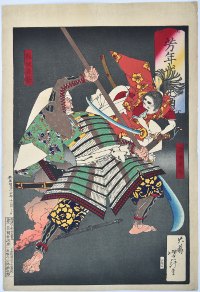
Click here to view image full size.
Minamoto no Ushiwakamura battling with Kumasaka Chohan. From the fine set Yoshitoshi mushaburui, “Yoshitoshi’s Courageous Warriors.” Published by Kobayashi, 1883-1886 (this being 1883).
Fine impression and colour. Light toning, otherwise fine condition. This is the first edition. There are a number of later states and the set was republished by Tsunajima in 1886.
Status: Sold
Tsukioka YOSHITOSHI (1839-1892)

Click here to view image full size.
An original painting, sumi and touches of red on paper, 26 x 11.5 in; 66 x 29.2 cms. A spontaneous painting of a beauty raising the hem of her kimono as she rushes to an appointment. Several small restorations only viewable obliquely, otherwise good condition.
Signed in cursive script which he used from 1887: Yoshitoshi ga. Small seal too indistinct to read.
Status: Sold
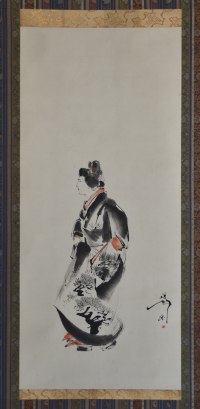
Click here to view image full size.
Tsukioka YOSHITOSHI (1839-1892)
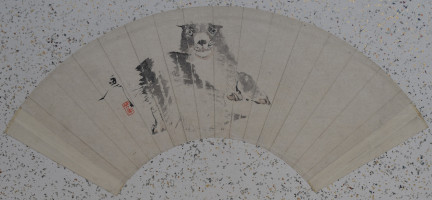
Click here to view image full size.
An original fan painting, sumi on treated paper, 17.5 x 5.5 in; 44.5 x 14 cms. Shows two dogs – possibly Chin. In very good condition: As nearly always, showing the rib folds of the fan. Tipped onto gold-speckled board. Signed and sealed Yoshitoshi.
Status: Sold
Tsukioka YOSHITOSHI (1839-1892)

Click here to view image full size.
A fine and large original painting, sumi and light colour on silk. Image size 45.5 x 20.25 in; 115.5 x 51.5 cms. Shows Kato Toranosuke (1562-1611) and Yamaji Shogen (1546-1583) locked in combat having fallen over a cliff into a river. A full moon above. Toranosuke (Kiyomasa), a bodyguard of Toyotomi Hideyoshi, was one of the “Seven Spears of Shizugatake,” Shizugatake no shichi-hon-yan. His adversary is Yamaji Shogen of Katsuie Shibata’s army. (In fact, he defected to Katsuie from Hideyoshi during the battle and was killed there – presumably by Toranosuke .) The battle of Shizugatake was in 1583.
Signed Ikkaisai Yoshitoshi hitsu. Signature of c. mid 1860s. Recently remounted and in fine condition. The detail on the armour and accoutrements is exceptional.
Status: Sold
Tsukioka YOSHITOSHI (1839-1892)
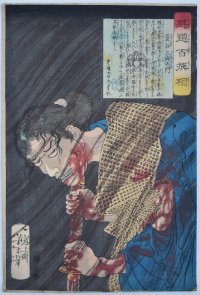
Click here to view image full size.
A bloodied Sugenoya Kuemon resting his head on the hilt of his sword in stormy weather from a set Kaidai hyaku, “Yoshitoshi’s Selection of One Hundred Warriors.” Sixty-five prints published by Ohashiya Yashichi between 1868 and 1869, this being 1868. The text in the square cartouches in this set refer to prominent warriors in the internecine wars of the 16th century but in fact the subjects are Shogitai soldiers. (Those that held out against the imperial forces and were massacred at Ueno, 4/7/1868.) Possibly the best design from this fine set.
Fine impression of the early state with dark background and yellow at the bottom of the title cartouche. Fine colour and condition. Signed Ikkaisai Yoshitoshi htsu.
Status: Sold
Tsukioka YOSHITOSHI (1839-1892)
Click here to view image full size.
The demon Ibaraki of Rashomon ( a gate south of the Imperial Palace in Kyoto ) visits Watanabe no Tsuna disguised as an old woman to retrieve its severed arm. This famous story relates how Watanabe cut off the arm after camping out at the gate to rid the neighbourhood of the beast. ( See below on this website for Yoshitoshi’s vertical diptych of the same subject. ) From Yoshitoshi manga, “Sketches by Yoshitoshi” from a fine set of seven diptychs. Published by Kobayashi 1885-86 ( this being 1885 ).
Very fine impression of the first edition. Fine colour. Fine condition apart from one minor mark. As originally published with no backing paper, with the margins completely untrimmed ( often cut in this set ), and plenty of space for joining. Signed Yoshitoshi ga.
Status: Sold
Tsukioka YOSHITOSHI (1839-1892)
Click here to view image full size.
The best design from the set Tsuki hyakushi, the “Hundred Phases of the Moon”. The set published between 1885 and 1892 ( this being 1886 ) by Akiyama Buemon. Benkei against a full moon. In 1185 Yoshitsune attacked by his half-brother Minamoto no Yoritomo, was forced to flee to northern Japan by ship. Sailing along the Inland Sea off the coast of Harima Province not far from Kyoto, the ship was struck by a storm in Daimotsu Bay caused by the vengeful ghosts of the Taira warriors Yoshitsune and his men had slain. Benkei pacified the spirits in the prow of the boat by holding up his string of prayer beads.
Fine impression, colour and condition. (A good guide to the quality of the impression is to look at the outline of Benkei’s face: This fine line started to break down early on.) An impression that has not been in an album: Full margins with very extensive mica. Signed Yoshitoshi.
Status: Sold
Tsukioka YOSHITOSHI (1839-1892)
Click here to view image full size.
Hohodemi Mikoto battling a giant bream to regain the magic fish hook. The best design from a fine chuban set Biyu Suikoden published by Omiya Kyujiro, 1866/7 (this being 1867). He eventually marries the Sea God’s daughter Princess Toyotama. There is a later edition with the publisher’s name removed.
Very good impression, colour and condition. Signed Kaisai Yoshitoshi hitsu.
Status: Sold
Tsukioka YOSHITOSHI (1839-1892)
Click here to view image full size.
Takagi Umanosuke, a seven foot tall Jujutsu master, holding a trial of courage with a giant ghost in an ancient temple. He also mastered the arts of Bojutsu (staff), Sojutsu (spear), and Naginarajutsu (halberd). One of the best designs from a fine chuban set Biyu Suikoden published by Omiya Kyujiro, 1866/7 (this being 1866). There is a later edition with the publisher’s name removed.
Very good impression and colour.One small mark, otherwise good condition. Signed Kaisai Yoshitoshi hitsu.
Status: Sold
Tsukioka YOSHITOSHI (1839-1892)
Click here to view image full size.
Roba kiwan o mochisaru zu, the best design from Shinkei sanjurokkaisen, “New Forms of Thirty-Six Ghosts.” The set published by Sasaki Toyokichi, 1889. The well-known story relates how Watanabe no Tsuna cuts off the arm of the demon Ibaraki near the Rashomon Gate in Kyoto in 976. Watanabe locks the arm in a box. Subsequently he is visited by his wet-nurse who asks to see the arm, whereupon she seizes it and flies off revealing her true guise as that of the demon. The story was made into a no play, Ibaraki, and later a kabuki play.
Very fine first edition, fine colour and condition. Full size with the publishing details intact on left margin. The second edition (with only two-colour cartouche) is shown on the front cover of The Age of Yoshitoshi, The Rijksmuseum, 1990 and no. 47, p. 40. Signed Yoshitoshi.
Status: Sold
Tsukioka YOSHITOSHI (1839-1892)
Click here to view image full size.
Fushimi ojishin Momoyama goten no zu. Shows Kato Kiyomasa protecting Toyotomi Hideyoshi during the earthquake which destroyed the Fushimi castle two years after it was completed in 1594. Published by Fukase, 1885.
Very fine impression, colour and condition with extra paper around. Signed Oju Taiso Yoshitoshi ga.
Status: Sold
Tsukioka YOSHITOSHI (1839-1892)
Click here to view image full size.
Daininbo Umegae o satsugai no zu, “Picture of the Priest Dainin Killing the Girl Umegae from the set Shinsen azuma nishiki-e, “New Selection of Eastern Brocade Pictures.” The set was based on episodes from kabuki drama although set in naturalistic surroundings. Published by Tsunashima Kamekichi between 1885-89 (this being 1886).
Very fine impression, colour and condition. Full, untrimmed yellow borders. Two-colour cartouche: Supposedly the first edition has three-colour cartouche but this impression could not be better, so presumably the printer had a forgetful day. Signed Yoshitoshi.
Status: Sold
Tsukioka YOSHITOSHI (1839-1892)
Click here to view image full size.
The most gruesome of Yoshitoshi’s designs showing the old hag of the Lonely House about to eviscerate the pregnant woman hanging from the roof. Published by Matsui Eikichi, 1885.
Fine impression of the first edition. Little work has been done on the various states in this set other than that most were reprinted by Hasegawa Tsunejiro. Fine colour. Very full size with large margins left, top and where the sheets join. (The left border is often trimmed thereby losing the publication details.) Minor soil, otherwise fine condition. On thick hosho. Signed Oju Yoshitoshi.
Status: Sold
Tsukioka YOSHITOSHI (1839-1892)
Click here to view image full size.
Kesa Gozen writing her last words before dying for her husband, the palace guard Minamoto Wataru from the set Kokoku nijushiko, “The Twenty-four Accomplishments in Imperial Japan.” Published by Tsuda Genshichi, 1881-87 (this being 1887). This is the first edition. It was republished by Matsuki Heikichi with altered signatures and other changes and inferior printing.
Very fine impression, colour and condition. Superb gradation and blind-printing. Signed Taiso Yoshitoshi ga.
Status: Sold
Tsukioka YOSHITOSHI (1839-1892)
Click here to view image full size.
Torii Suheemon Katsutaka escaping the castle of Okudaira Nobumasa, which is being attacked by Takeda Katsuyori, in order get help from Tokugawa Ieyasu. From the set Kokoku nijushiko, “The Twenty-four Accomplishments in Imperial Japan.” Published by Tsuda Genshichi, 1881-87 (this being 1887). This is the first edition. It was republished by Matsuki Heikichi with altered signatures and other changes and inferior printing.
Very fine impression, colour and condition. Superb gradation on the piers with gofun added to the sumi. Signed Taiso Yoshitoshi ga.
Status: Sold
Tsukioka YOSHITOSHI (1839-1892)
Click here to view image full size.
Zennojo, the filial son from Shinano Province, dreams of his father’s crimes and successfully prays for his recovery from illness. From the set Kokoku nijushiko, “The Twenty-four Accomplishments in Imperial Japan.” Published by Tsuda Genshichi, 1881-87 (this being 1887). This is the first edition. It was republished by Matsuki Heikichi with altered signatures and other changes and inferior printing.
Very fine impression, colour and condition. Superb gradation and burnishing. Signed Taiso Yoshitoshi ga.
Status: Sold
Tsukioka YOSHITOSHI (1839-1892)
Click here to view image full size.
A vertical diptych showing Taira no Atsumori and Kumagai Naozane at the battle of Ichinotani in 1184. The story relates how Naozane cuts off the head of Atsumori but is overwhelmed by remorse because he looked so much like his son. Published by Matsui, Meiji 18, 1885.
Superb impression. Very fine colour and condition with ample room for joining. Untrimmed. (An essential with this set as the publishing information is often on the left margin.) The first edition (indeed, this may be the earliest state of the first edition). Signed Oju Yoshitoshi ga.
Status: Sold
Tsukioka YOSHITOSHI (1839-1892)
Click here to view image full size.
A vertical diptych showing Taira no Koremochi about to kill the female demon whose reflection he sees in a stream on Mount Togakushi in Shinano. The episode follows an excursion to view the autumn maples. He encounters a party of girls who invite him to join them to only become intoxicated and fall asleep. He is aroused by terrifying sounds emanating from the devil. The No play Momijigari, “Maple Picnic” is based on this story. Published by Matsui, Meiji 20, 1887.
Superb impression. Very fine colour and condition with ample room for joining. Untrimmed. (An essential with this set as the publishing information is often on the left margin.) The first edition. Signed Oju Yoshitoshi ga.
Status: Sold
Tsukioka YOSHITOSHI (1839-1892)
Click here to view image full size.
Hatakeyama Shoji Shigetada wounded by soldiers of his Lord Hojo Tokimasa. One of the best designs from a fine set: Yoshitoshi musha burui, “Yoshitoshi’s Courageous Warriors” published by Kobayashi Tetsujiro, 1883. This is the first edition with two red seals left margin, complete date with day, month and year in left margin and three-colour cartouche. Subsequent editions were printed with only two-colour cartouche and then just one colour. It was also reprinted by Tsunajima Kamekichi in 1886.
Fine impression and colour. Slight browning, otherwise very good condition. Signed Taiso Yoshitoshi ga.
Status: Sold
Tsukioka YOSHITOSHI (1839-1892)
Click here to view image full size.
Hojo Tokimasa praying to a goddess in the sea. One of the best designs from a fine set: Yoshitoshi musha burui, “Yoshitoshi’s Courageous Warriors” published by Kobayashi Tetsujiro, 1883. This is the first edition with two red seals left margin, complete date with day, month and year in left margin and (on this design) a two–colour cartouche. Subsequent editions were printed with only one colour. It was also reprinted by Tsunajima Kamekichi in 1886.
Fine impression and colour. Burnishing and mica added. Slight browning, otherwise very good condition. Signed Taiso Yoshitoshi ga.
Status: Sold
Tsukioka YOSHITOSHI (1839-1892)
Click here to view image full size.
Lu Ta ( Lu Chi Shen ) demolishing the gate of the temple of the Five-Crested Mountain. A Chinese captain, he accidentally killed a man and to escape death he became a priest at the temple. The abbot cut his hair and renamed him Lu Chi Shen, “Lu of Deep Wisdom.” However, quickly disregarding priestly vows, he became violent again and drank heavily. Staggering back one night he shattered the temple gate fighting the huge wooden guardian figures. The abbot dismissed him and he reappears as one of the 108 heroes of the Suikoden. Published by Matsui 1887.
Very fine impression of the earliest state of the first edition with blind printing and burnishing. This design was reprinted by Hasegawa with seal in upper left margin “Reproduction not permitted” and lacking date. Also, the lovely pigment used to colour the torso of the guardian figure ( which oxidizes ) is replaced with an inferior colour . There are also intermediate printings between first and Hasegawa version. Fine colour. Some discolouration on the reverse not affecting the front, otherwise fine condition with left margin intact. On thick hosho: These vertical designs must have the left border uncut as it often contains publication information. Signed Yoshitoshi.
Status: Sold
